This is the outline for the "after liturgy" talk that is customarily given in our church, before it is too chaotic to teach. The plan is to give this talk tommorow, with the material below as a handout. I "try" to keep things short, so by no means is the talk comprehensive.
Prosphora
Liturgy of Preparation, Proskimidia, Service of Prothesis
Offering Prosphora and names at the Liturgy.
What is prosphora?
· The bread used for the liturgy.
o Pure wheat flour, water, yeast, salt ONLY.
o ALWAYS leavened. – to celebrate the Resurrection
o ALWAYS two layers to symbolize the dual nature of Christ.
o Stamped on the top.
o Baked by the faithful as an offering.
§ The process of baking should be discussed another time.
Styles of Prosphora
§ Greek “Byzantine” style
§ L to R: Byzantine style stamp, Byzantine style prosphora.
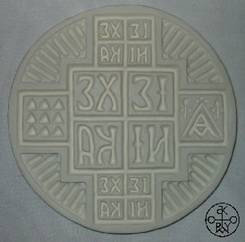
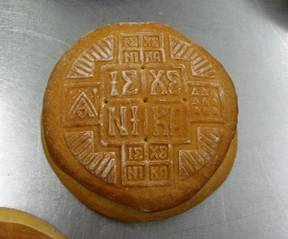
· One large loaf
· Stamp in the form of a cross, in 5 parts.
· Vertical:
o Three stamps IC XC NIKA ("Jesus Christ conquers")
o Top: commemorate the living
o Center – the Lamb, only part that will become the body of Christ
o Bottom – for the dead
· Horizontal
o Left: Triangular area:Theotokos
o Right: 9 small triangular pieces the nine ranks of commemorations
1. St John the Baptist
2. Prophets
3. Apostles
4. Hierarchs
5. Martyrs
6. Monastics and all righteous.
7. Unmercenary healers
8. Saints of the day and patron of the temple
9. Saint whose liturgy we celebrate (St John Chrysostom or St Basil)
§ Russian Style
§ L to R – Russian style stamp, 2 Russian style prosphora
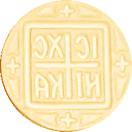
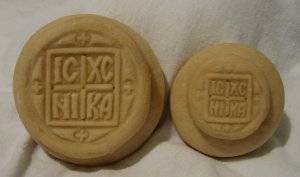
· Five separate loaves. – recalling Feeding of the 5000 (with 5 loaves and 2 fish)
· Usually the Theotokos loaf has a special stamp.
· Sometimes the loaf for the 9 ranks has a special stamp.
§ Prosphora for individual offering
· Smaller.
· Stamp of IC XC NIKA or sometimes a Saint or the Theotokos.
How is prosphora used?
- Two ways
-
- Collectively – Offered by all the people.
-
- The bread that will become the body of Christ
- Individually.
-
- Submitted with a list of names of the living and the dead.
- 1 or 2 loaves.
- Should be always with alms. (Some crudely call this “purchasing” a prosphora.
When is prosphora used?
- Liturgy of Preparation = Proskimidia” = “offering”= Prothesis (Gk. “setting forth”)
- Service before Divine Liturgy.
-
- By the priest only, with deacon.
- Five loaves prepared, placed on diskos for Divine liturgy.
- Priest commemorates people from his (usually very large) dyptichs.
- INDIVIDUAL PROSPHORA OFFERINGS SHOULD BE DONE AT THIS TIME.
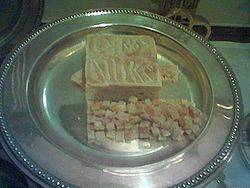 Diskos prepared for liturgy.
Diskos prepared for liturgy.
* The Lamb and particles placed on the diskos.
* The large triangle to the left of the Lamb is the particle for the Theotokos
* To the right of the Lamb are the particles for the nine ranks (saints)
* Below the Lamb are the particles commemorating the living and the departed.
Important pastoral notes.
· “The priest prays for the people and with the people but not instead of the people.”
o This means you should be present to offer your prosphora!
- Prosphora should be offered
-
- By the individual making the offering ONLY (not by proxy)
- With alms.
- Before the Divine Liturgy, so the priest can commemorate the names properly.
- Concerning names.
-
- Living and the Dead.
- For each Orthodox name (if there is time!) a particle is taken out and placed on the diskos.
-
- Near the end of the liturgy, after the communion of the faithful, all particles are poured into the chalice with the prayer: “By thy precious Blood, O Lord, wash away the sins of those here commemorated, through the intercessions of Thy saints. “
- Clearly, non Orthodox do not commune from the chalice, so neither should non Orthodox be commemorated with a particle, which will be put in the chalice
- Orthodox names should be used – no nicknames, etc
- It really helps if you *print* legibly. It is REALLY frustrating to try to make out bad handwriting. Russian cursive is almost impossible for me to read.
- Non-Orthodox must be clearly marked.
-
- Non-Orthodox are not “placed on the diskos”, but I always pray for all names. Christians pray for everyone, but do not pray for everyone in the exact same way.
- What happens when prosphora is offered late?
-
- The priest’s prayer is disrupted.
-
- He should never leave the front of the altar except when the service calls for movement. Concentration is difficult.
- The names are not commemorated properly.
- The commemorations may be missed.
Locally at St Nicholas
- Everyone must offer their own prosphora. If a person is sick, of course, arrangements can be made with a friend to offer their commemoration book, but this is the exception, not the rule.
- Please indicate clearly if a person is not Orthodox.
- Use Orthodox names, not nicknames, etc.
- There are commemoration books in back, and commemoration slips, for the living and dead. . Each person must individually get a prosphora and offer it along with their book or slip(s).
- I am asking people to make a good faith effort to offer prosphora before the Liturgy begins.
- We do not have a strict cutoff” times when prosphora are not accepted, but keep in mind that any prosphora offered after the liturgy starts cause a problem for the priest and guarantee that individual particles for each name will not be taken out, and definitely, none are accepted after the Great Entrance.
- Keep in mind that my dyptichs are extensive and all current/past/sometime parishioners are commemorated.
References
Service of the Proskimidea http://www.orthodox.net/services/proskomede.html (also in PDF and DOC formats)
http://en.wikipedia.org/wiki/Liturgy_of_Preparation
http://www.stmarkorthodox.org/prosphora.html
Priest Seraphim Holland 2010 St Nicholas Russian Orthodox Church, McKinney, Texas
This outline is at:
New catechism outlines, Journal entries, homilies, etc. are on our BLOG: http://www.orthodox.net/redeemingthetime
Articles Archive: http://www.orthodox.net/articles
Journal Archive: http://www.orthodox.net/journal
Catechism Archive: http://www.orthodox.net/catechism
Blog posts & local parish news are posted to our email list. Go to here: http://groups.google.com/group/saint-nicholas-orthodox-church to join.
Use this for any edifying reason, but please give credit, and include the URL of the article. This content belongs to the author. We would love to hear from you with comments! (seraphim@orthodox.net)
Great teaching tool Father, I will use it, Fr. William John Clark. Most in the ROEA refer to me as FR Bill I was a school director and camp priest many times, the kids call me frbill and it stuck, May God Bless you Father and your God protected parish. In Christ Fr William John
Thank you, Father Seraphim, for this info. Please don't take it off your blog or off your website.